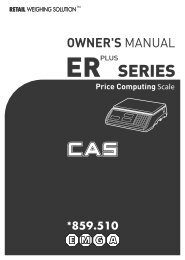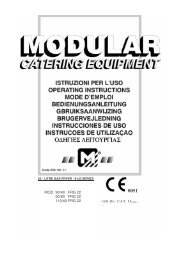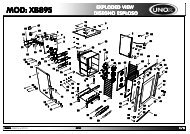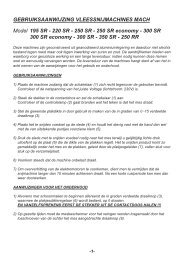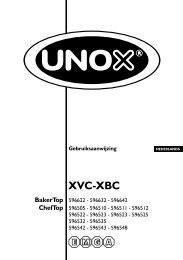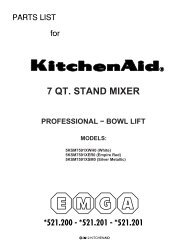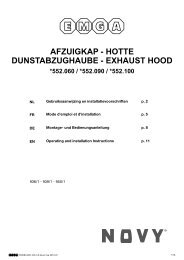Create successful ePaper yourself
Turn your PDF publications into a flip-book with our unique Google optimized e-Paper software.
Gas connections<br />
51<br />
ChefTop <br />
BakerTop <br />
Checking the nominal heating capcity<br />
The heating capacity should be checked by authorised personnel or the responsible organisation, on the basis of the data<br />
provided in this operating manual. This check should be performed for new installations, transformations or adaptations<br />
to other types of gas, and after every maintenance procedure.<br />
The nominal heating capacity and connection pressures can be obtained using the technical data table. Components<br />
sealed with red paint must never be adjusted.<br />
The specified nominal heating capacity is obtained using the nozzles as described in the correpsonding table in the<br />
Technical data booklet, at the connection pressure specified for each type of gas.<br />
If you wish to carry out a further nominal heating capacity check, it can be performed using the volumetric method, by<br />
means of a meter and a timer.<br />
The exact volume which should pass through per time unit can be found in the correspinding table in the Technical data<br />
booklet. This connection value should be maintained in the specified area, with a tolerance of ±5%. If any deviations are<br />
detected, you should make sure that the nozzles fitted have the correct diameter and are being used with the correct inlet<br />
pressure.<br />
Checking the connection pressure<br />
The connection pressure should be measured while the appliance is in operation, using a fluid pressure measuring device<br />
(for example, a "U"-shaped pressure gauge with a resolution of 0.1 mbar or an electronic pressure gauge); make sure the<br />
recorded pressure value matches the value provided in the corresponding table.<br />
To check the inlet pressure, shut off the upstream gas valve and remove the gas supply pipe, inserting a T-fitting between this pipe<br />
and the gas inlet of the oven; connect a suitable pressure gauge to the free terminal on the T-fitting and record the reading.<br />
If the recorded pressure value is much lower than the the value indicated in "CHART A" (more than 0.2 mbar below<br />
the value indicated in the table), contact your local gas supplier.<br />
Caution!<br />
Solenoid valve components which have been adjusted and sealed by the manufacturer should not be tampered with for<br />
any reason.<br />
Operational check<br />
Start the appliance in accordance with the operating instructions.<br />
Make sure the appliance does not leak.<br />
Check the formation, cross-lighting and appearance of the flames through the burner venilation openings; it is particularly<br />
important that the flames are strong and bright blue in colour, with no yellow tips.<br />
User recommendations<br />
The technician responsible for installation must instruct the customer/user on the fundamental safety aspects regarding<br />
oven operation, referring to the information contained in this "Instruction manual" supplied with the oven. Every nonroutine<br />
maintenance procedure (replacing malfunctioning components, adapting to other gases, etc.) must be performed<br />
by a technician with the necessary professional qualifications; once these procedures have been completed, a general<br />
operational check of the oven is required.<br />
For this reason we recommend a maintenance contract is drawn up, stipulating that the appliance is inspected - and the<br />
electrical, gas and plumbing connections thoroughly checked - at least twice a year.<br />
The end user accepts full responsibility for the daily operation and cleaning of the appliance.<br />
English



